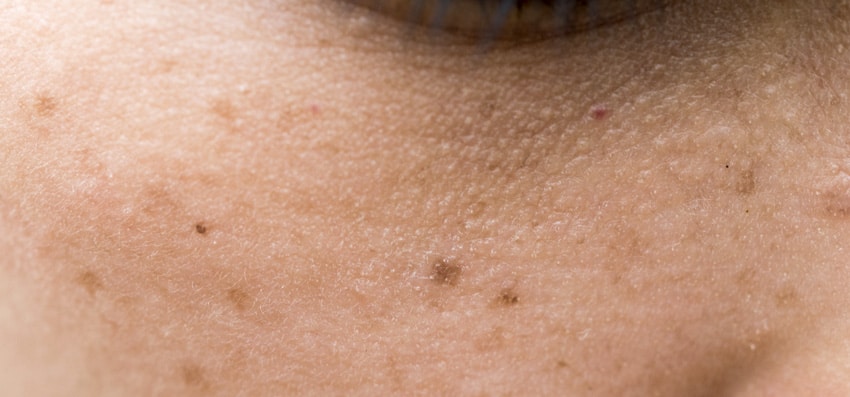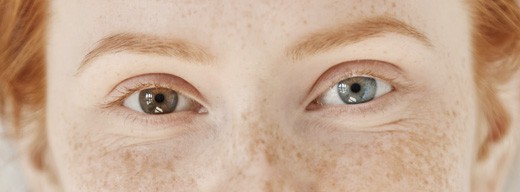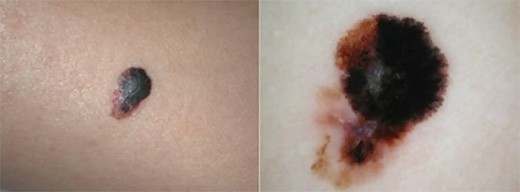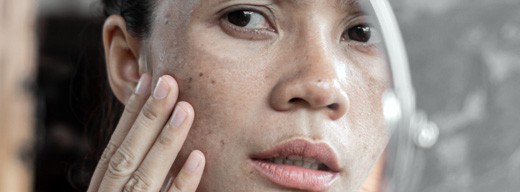
OC 949-428-4500
LA 310-460-2444

There are many different methods and treatments for removing freckles. From high tech laser treatments to low-tech DIY home remedies that you can find in your local grocery store.
Which will work for you really depends on your unique physiology. While all of the following methods work to remove freckles, you will have to experiment to see which works best for you. There is no “silver bullet” that will work 100% of the time for 100% of people.
Freckles are small, dark macules on the skin that can have tints of yellow, red, tan, brown, or black. They are composed of small clusters of cells that produce excessive melanin. Melanin is the substance that gives our skin complexion its color. In the scientific world they are known as ephelides and solar lentigines.
Both ephelides and solar lentigines are affected by sunlight. The major difference between the two is that ephelides are induced by sunlight but caused by genetics, whereas solar lentigines are induced by sun exposure and photo-damage of the skin. For the purpose of this article we are going to primarily focus on ephelides. If you would like to learn more about solar lentigines, AKA age spots, please see this article.
Freckles usually get darker during summertime and lighter in the winter months. They are most common on the face, but may appear on arms, shoulders, and the rest of the body. People with a lighter complexion are more prone to having or developing freckles and they begin to appear in early childhood..
Freckled people have a higher sensitivity to UV light. Because of this, it is highly recommended that they use a high SPF “Broad Spectrum” Sunscreen when tanning or going out in the summer sun. Sunscreen, Sunscreen, Sunscreen, the use of Sunscreen can not be stressed enough!
Freckles are associated with the Melanocortin-1-receptor, variants of which are also associated with fair skin and red hair. Although having the MC1R gene does not mean you will automatically develop freckles. Having no copies of the MC1R gene does not guarantee freckles will not appear. An example of this can be seen in the Asian countries where people still have freckles while not having red hair.
It is thought variants of the gene responsible for freckles developed about about 250 250 thousand years when humans left the African continent. Originally, this gene handled the much needed dark skin in the African Environment, thanks to its high melanin content that protected the skin from UV exposure. As humans moved on to less sunny areas, skin got lighter to still absorb enough UV to produce the much-needed vitamin D

Caused by genetics, freckles are highlighted by sunlight, which causes melanocytes (cells that create melanin) to overproduce melanosomes. This will make the keratinocytes (the cells on the last layer of your skin) change color and appear darker than the rest of the skin.
They usually appear in the first years of age. There have been cases, however, where adults claimed freckles appeared on their skin during the summer months, without having them before. These types of freckles are referred to as solar lentigines, or age spots .

Contrary to popular belief, they are not a skin disorder and common ones do not develop into skin cancer. However, they are strong risk indicators for melanoma and non-melanoma skin cancer. Freckles of unusual shape or size could become malignant and should be checked out by your dermatologist.
Freckles are not a sign of disease or an unhealthy lifestyle, nor a danger to one’s life and health. While some people love their freckles and others don’t mind them, there are certain cases in which freckles are a huge drawback to someone’s appearance. Here’s everything you need to know about how to remove freckles and how to keep them away.
Since freckles are spots on the skin that tan much faster than the rest of your skin, the best way to treat freckles is to avoid sunlight. A wide range of creams, serums, and other kinds of treatment are available; some work better, while others barely make a difference. If you want to get rid of freckles, the best way to do so is using a combination of treatments.
However, remember that these are only temporary, depending on how long you stay away from sunlight. In addition, be extra careful to protect yourself from UV rays while undergoing treatment. This is because exposing freckles to the sun will only decrease your success rate.
Unfortunately there is no straight-forward answer. Some removal methods work wonders for some people and for others, not so much.
The effectiveness of the treatment is also highly dependent on who and where it is being performed. It is an at home remedy or is it a treatment provided by a medical clinic. The latter having the most dramatic results.
Every treatment listed below has it’s advantages and disadvantages. A combination of these will most likely end up producing the best results for you particular skin. Definitely try out some of the all natural at home remedies first before moving on the the more invasive and expensive, medical treatments.

Hydroquinone creams can be purchased without a prescription if they contain less than 2% hydroquinone. We don’t recommend this as the non-prescription versions are not very effective. We recommend using a cream with 4% hydroquinone which will require a trip to the doctor. This is good thing as we don’t recommend using a cream containing hydroquinone without first seeking out the advice of a medical professional.
Kojic Acid (KA) is another agent to look for in skin creams. KA is a natural metabolite produced by fungi that has the ability to suppress melanin formation and hyperpigmentation. A lot of formulations of KA tend to lighten the color of the skin surrounding the freckles too. Therefore, seek medical advice when picking out which fading cream is best for you.
A good fading cream can cost $30 to a few thousand dollars, depending on the brand, quantity, and ingredients.
Tretinoin, tazarotene, isotretinoin, retinaldehyde and adapalene are all retinoid formulations that are derived from vitamin A or have structural and/or functional similarities with vitamin A.
If applied generously and regularly, they can help lighten freckles over a few months. Combining retinoids with other treatments such as laser or IPL is a great combination for removing freckles.
The only downside to retinoids is they have been known to cause irritation, redness and dryness of the skin. Be sure to try it out on a small area to see how your skin reacts before applying generously.
A good retinoid regimen can start at about $50 and go as high as $600 or more.
Laser treatments top the list for effectiveness in removing freckles. Especially when the are used in combination with fading creams such as hydroquinone.
The laser energy is absorbed by the melanin in the freckle. which stimulates your skins natural “melanin turnover” system which removes old melanin and replaces it with new evenly toned skin.
The cost of laser treatment can vary greatly depending on what laser is being used and whether nurse or doctor is performing the treatment. Be prepared to pay anywhere from $300 to $650 per treatment. Typically it takes 2-5 treatments to see results
Similar to Laser treatment, but not quite as effective, IPL is a safe and effective treatment for removing and lightening freckles. IPL works with an intense and pulsating beam of light, hence the name, Intense Pulsed Light.
With IPL it usually takes 5 to 6 sessions before you start seeing results. Cost can range from $175 to $350 per treatment.
While some of the above treatments for removing freckles are more expensive, like Laser treatment or IPL, others, like creams and retinoids can be very affordable and easy to use. Which treatment will be right for you is nearly impossible to predict since each varies greatly from one individual to another. The best place to start is at your local medical office. They have seen 1000s of patients, all with different skin, and will have a pretty good idea where to start.
However, if you are on a tight budget and want to try and remove your freckles without the advice (or cost) of a doctor, the following all natural methods to remove freckles are the best place to start. And remember, an ounce of prevention is worth a pound of cure… sunscreen, sunscreen, sunscreen is the best way to prevent, and keep away once removed, your freckles.

There are many natural substances and treatments for freckles with more or less impressive success rates. However, for the best results we recommend using at least 2 or 3 of these suggestions:
Lemon juice is a very effective natural bleach thanks to high Vitamin C content. It used to lightened both skin and hair.
To use, apply fresh juice to your skin, massage, let sit and rinse off with warm water after about 15 minutes.
A combination sugar and lemon juice scrub also works great. However, be careful to only use it twice a week at most.
Dairy masks work to lighten freckles and make the skin look smooth, supple and, moisturized, thanks to the lactic acid and other active ingredients.
There is quite a bit of clinical evidence showing that a topical application of lactic acid is effective for depigmentation as well as for improving mild wrinkling.
Creating a peeling mask out of blended fruit is one of the most common skin health tips from dermatologists. Strawberries, kiwi, and papaya are known for their skin lightening abilities.
If you want the best results, you can throw in a lemon, some yogurt and a spoonful of honey.
Mixing honey with warm water will give decent results over time. In fact, a recent study showed that honey extracts exhibited significant anti-aging properties.
However, the best way of using honey to lighten your freckles is mixing it with lemon juice or into a fruit mask. This will greatly accelerate visible results and will also rejuvenate the skin.
No, with modern medical equipment doctors are able to precisely treat small areas such as freckles. Freckle removal involves very little risk for the patient if the procedure is performed by a qualified practitioner.

Yes and No. It depends on the treatment. Most treatments only remove the extra pigment in the freckle, not the cause of it’s overactive melanin production.
Some laser treatments on the other hand actually reset the overactive production of melanin. This will permanently remove the freckle.
Keep in mind, if you already have freckles then you are susceptible to getting more. Sunscreen, sunscreen, sunscreen! You don’t want to spend all this time and money removing your freckles only for more to return..
A quick Google search for “how to remove freckles” will lead you to some great answers and to some straight-up crazy suggestions you should never try. Here are a few ground rules in dealing with freckles:
DO use sun protection. People with freckles usually are more vulnerable to effects of UV radiation, so avoid sunlight without strong protection (SPF 40+ and “Broad Spectrum”), especially during peak sun times.
DO apply and eat Vitamin C. It works against freckles from the outside and the inside, so eating fruits is another way to diminish the dark color of freckles.
DO wear hats, especially those with a wide brim. This will protect freckled skin from sunlight and will keep them light.
DO NOT expose freckles to the sun. Although many people believe that tanning will darken the skin around the freckles so they won’t be as visible anymore, this will never happen. Freckles will always be darker than skin with a normal concentration of pigment.
DO NOT use fading creams without doctor’s prescription. Some fading creams work great, but others also bleach the skin surrounding the freckles which will lead to an excessively light complexion.
Freckles can be a cool natural enhancement to one’s looks, but they can also be a huge drawback for one’s self-esteem. Although the freckles themselves are not dangerous in any way health wise, some people remove them for a clean and even complexion.
AMA Regenerative Medicine & Skincare | 1570 Brookhollow Dr., Santa Ana, CA 92705 | 6310 San Vicente Blvd STE 285, Los Angeles, CA, 90048 | Privacy Policy